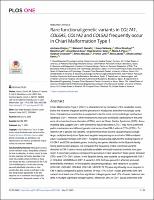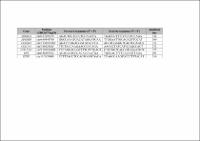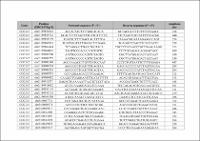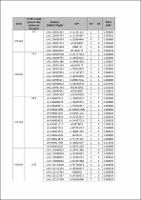| dc.contributor | Vall d'Hebron Barcelona Hospital Campus |
| dc.contributor.author | Urbizu, Aintzane |
| dc.contributor.author | Garrett, Melanie E. |
| dc.contributor.author | Soldano, Karen |
| dc.contributor.author | Drechsel, Oliver |
| dc.contributor.author | Loth, Dorothy |
| dc.contributor.author | Marcé Grau, Anna |
| dc.contributor.author | Poca Pastor, Ma Antonia |
| dc.contributor.author | Mestres Soler, Olga |
| dc.contributor.author | Macaya Ruíz, Alfons |
| dc.date.accessioned | 2021-12-27T13:26:10Z |
| dc.date.available | 2021-12-27T13:26:10Z |
| dc.date.issued | 2021-05-11 |
| dc.identifier.citation | Urbizu A, Garrett ME, Soldano K, Drechsel O, Loth D, Marcé-Grau A, et al. Rare functional genetic variants in COL7A1, COL6A5, COL1A2 and COL5A2 frequently occur in Chiari Malformation Type 1. PLoS One. 2021 May 11;16(5):e0251289. |
| dc.identifier.issn | 1932-6203 |
| dc.identifier.uri | https://hdl.handle.net/11351/6738 |
| dc.description | Secuenciación de genes; Genómica; Imágenes por resonancia magnética |
| dc.language.iso | eng |
| dc.publisher | Public Library Science |
| dc.relation.ispartofseries | PLoS One;16(5) |
| dc.rights | Attribution 4.0 International |
| dc.rights.uri | http://creativecommons.org/licenses/by/4.0/ |
| dc.source | Scientia |
| dc.subject | Tub neural - Malformacions |
| dc.subject | Genòmica |
| dc.subject.mesh | Arnold-Chiari Malformation |
| dc.subject.mesh | /genetics |
| dc.subject.mesh | Genetic Variation |
| dc.title | Rare functional genetic variants in COL7A1, COL6A5, COL1A2 and COL5A2 frequently occur in Chiari Malformation Type 1 |
| dc.type | info:eu-repo/semantics/article |
| dc.identifier.doi | 10.1371/journal.pone.0251289 |
| dc.subject.decs | malformación de Arnold-Chiari |
| dc.subject.decs | /genética |
| dc.subject.decs | variación genética |
| dc.relation.publishversion | https://doi.org/10.1371/journal.pone.0251289 |
| dc.type.version | info:eu-repo/semantics/publishedVersion |
| dc.audience | Professionals |
| dc.contributor.organismes | Institut Català de la Salut |
| dc.contributor.authoraffiliation | [Urbizu A] Duke Molecular Physiology Institute, Duke University Medical Center, Durham, NC, United States of America. Grup de Recerca en Neurologia Pediàtrica, Vall d’Hebron Institut de Recerca (VHIR), Barcelona, Spain. [Garrett ME, Soldano K] Duke Molecular Physiology Institute, Duke University Medical Center, Durham, NC, United States of America. [Drechsel O] Genomic and Epigenomic Variation in Disease Group, Centre for Genomic Regulation (CRG), The Barcelona Institute of Science and Technology, Barcelona, Spain. Universitat Pompeu Fabra, Barcelona, Spain. [Loth D] Department of Psychology, Conquer Chiari Research Center, University of Akron, Akron, OH, United States of America. [Marcé-Grau A, Macaya A] Grup de Recerca en Neurologia Pediàtrica, Vall d’Hebron Institut de Recerca (VHIR), Barcelona, Spain. [Mestres I Soler O] Unitat de Recerca en Neurotraumatologia i Neurocirurgia, Vall d’Hebron Institut de Recerca (VHIR), Barcelona, Spain. Universitat Autònoma de Barcelona, Bellaterra, Spain. [Poca MA] Unitat de Recerca en Neurotraumatologia i Neurocirurgia, Vall d’Hebron Institut de Recerca (VHIR), Barcelona, Spain. Universitat Autònoma de Barcelona, Bellaterra, Spain. Servei de Neurocirurgia, Vall d’Hebron Hospital Universitari, Barcelona, Spain. Universitat Autònoma de Barcelona, Bellaterra, Spain |
| dc.identifier.pmid | 33974636 |
| dc.identifier.wos | 000664626600028 |
| dc.rights.accessrights | info:eu-repo/semantics/openAccess |

 Área privada
Área privada Contacto
Contacto












